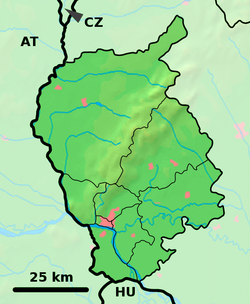Dunajská_Lužná
Dunajská Lužná
Village in Slovakia
Dunajská Lužná (Hungarian: Dénesdtorcsmisérd) is a municipality (village) in the Bratislava Region of western Slovakia in Senec District.
This article needs additional citations for verification. (March 2009) |
Dunajská Lužná lies approximately 15 km from the capital city of Bratislava towards Dunajská Streda and Komárno. It was founded on 1 January 1974 consisting of three formerly separate villages – Nové Košariská (German: Mischdorf, Hungarian: Misérd)[citation needed], Jánošíková (German: Schildern, Hungarian: Dénesd)[citation needed] and Nová Lipnica (German: Tartschendorf, Hungarian: Torcs)[citation needed]. Dunajská Lužná belongs to the vicinity of Bratislava. There is increasing building activity because of new inhabitants coming from Bratislava or other cities.
Not far from the municipality towards Senec lie two lakes - Malá Voda and Piesková Jama. They are used for fishing and bathing and in summer months they are quite crowded. Near the township runs a dam, protecting the villages and townships all the way from Bratislava to Gabčíkovo from flooding of the Danube River.
There is a large Roman Catholic community in Dunajská Lužná with the Church, devoted to "The Elevation of the Holy Cross". Besides Roman Catholics there are also Lutherans and other religions.



